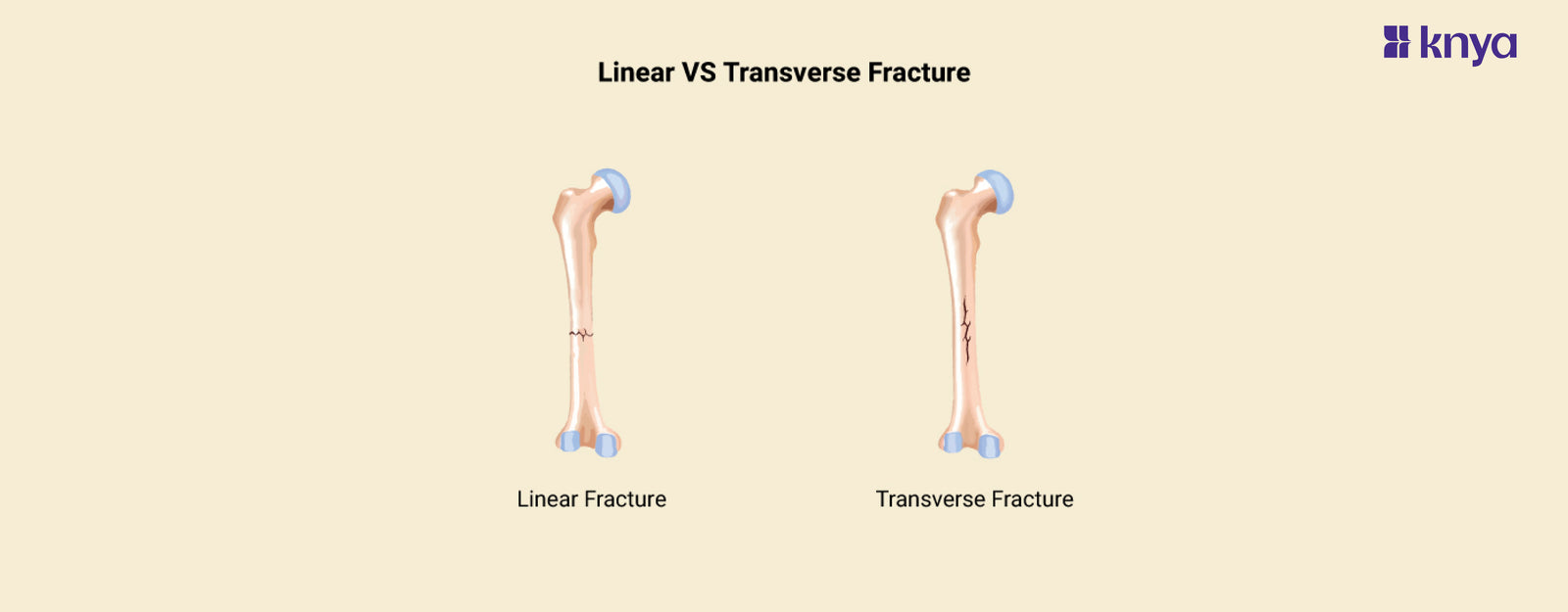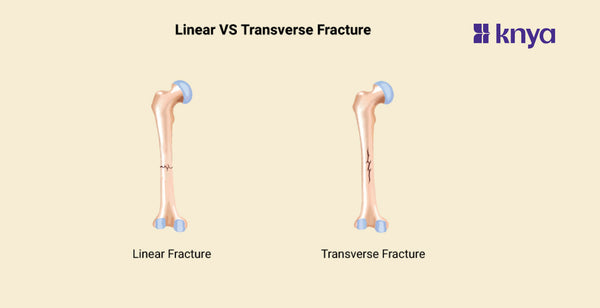Linear vs Transverse Fracture: Linear Fractures happen when a bone fractures in a straight line along its length, usually as a result of direct or indirect impact. These fractures typically affect long bones like the femur and humerus and range in severity from hairline cracks to complete breakage. Conversely, Transverse Fractures, which are usually brought on by an angle-applied stress, entail a break perpendicular to the long axis of the bone. Transverse Fractures are less common, but because of their clean break across the bone, they can be more stable. Nevertheless, both types of fractures require appropriate medical care to heal and recover.
Difference between Linear and Transverse Fracture
Linear Fractures occur when a bone breaks along its length, usually as a result of direct or indirect impact. Contrarily, Transverse Fractures entail a break perpendicular to the long axis of the bone, usually brought on by an angle-applied stress. The table below gives the differences between Linear and Transverse Fracture.
|
Aspect |
Linear Fracture |
Transverse Fracture |
|
Fracture Line |
Runs parallel to the bone's long axis |
Runs perpendicular to the bone's long axis |
|
Shape of Fracture |
Can vary from small cracks to complete breaks |
Typically creates a clean horizontal break |
|
Common Causes |
Direct or indirect trauma |
Force applied at a right angle to the bone |
|
Stability |
May vary in stability depending on severity |
Often offers more stability due to straight line |
|
Bone Affected |
Commonly observed in long bones like femur, tibia |
Can occur in any bone but often seen in long bones |
|
Treatment |
Depends on severity; may involve immobilization |
Immobilization and surgery may be necessary |
|
Healing Time |
Healing time may vary based on severity and age |
Generally shorter healing time due to stability |
|
Risk of Complications |
Depending on severity, risk may vary |
Lower risk of complications due to clean break |
Browse The Best Scrubs Collection!
What is Linear Fracture?
A break in the bone where the fracture line is parallel to the long axis of the bone is called a Linear Fracture. It usually comes from trauma and can range in severity from little cracks to full breaks. Treatment for this common condition, which affects long bones like the femur and humerus, varies according to severity and frequently entails immobilization or surgery for worse instances.
Causes of Linear Fracture
- Trauma: Trauma from falls, car crashes, sports injuries, or direct impacts to the bone is the most frequent cause of Linear Fractures. A break occurs when the force exerted on a bone surpasses its strength.
- Accidents: A Linear Fracture can be caused by any abrupt, strong blow to the bone. This can occur when engaging in contact sports, riding, or skiing.
- Osteoporosis: Even with little stress, the weakening of the bones brought on by osteoporosis increases their vulnerability to fractures. Individuals with osteoporosis may experience relatively small falls or stressors that result in Linear Fractures.
- Repetitive Stress: Stress fractures can be caused by overuse or repetitive stress on a bone, especially in athletes or people who engage in repetitive activity. These are tiny fissures in the bone, and if the pressure builds up, they may become Linear Fractures.
- Age: Bone brittleness and weakness increase with age, making fractures from stress or even small injuries more likely.
- Medications: Several drugs, especially those used to treat osteoporosis or long-term corticosteroid usage, can weaken bones and raise the risk of fractures.
Symptoms of Linear Fracture
- Pain: The most noticeable symptom is usually pain at the fracture site. Extreme pain is possible, especially while moving or applying pressure to the afflicted area.
- Swelling: Because of the inflammation and tissue damage brought on by the fracture, swelling is frequently seen in the vicinity of the injury. Additionally, there may be bruising (ecchymosis) to go along with the swelling.
- Tenderness: There may be a degree of tenderness in the vicinity of the fracture. Pain or discomfort might result even with light pressure.
- Deformity: The afflicted limb or bone may exhibit a noticeable deformity or incorrect alignment in certain circumstances, particularly in more severe fractures.
- Mobility Restrictions or Immobility: The extent of the fracture and its location will determine how difficult or impossible it is to move the affected limb or joint. Pain may worsen if you try to move the affected area.
- Crepitus: When the fragmented bone pieces scrape against one another, a feeling or sound of grinding or grating may be detected. Crepitus is the term for this condition, which can happen when the affected area moves.
What is Transverse Fracture?
A Transverse Fracture is a kind of bone break in which the fracture line forms a horizontal fracture and is perpendicular to the long axis of the bone. Transverse Fractures frequently result in straight breaks across the bone and are typically brought on by a force applied at a right angle to the bone. Because of their straight-line structure, they can provide greater stability than other forms of fractures, albeit being less common. Depending on how severe the break is, immobilization and surgery may be required as part of the treatment.
Causes of Transverse Fracture
- Direct Trauma: A Transverse Fracture may result from a blow or impact that strikes the bone directly. Falls, car crashes, sports injuries, or any other incident where a substantial amount of force is applied to the bone could cause this.
- Falls: Especially in long bones like the femur or tibia, falling from a height or slipping and landing on a leg can provide enough force to result in a Transverse Fracture.
- Sports Injuries: Transverse Fractures are more common in high-impact sports and activities that entail abrupt movements, collisions, or strong physical contact. Martial arts, football, rugby, and skiing are a few examples.
- Motor Vehicle Accidents: Impacts with hard surfaces can cause considerable stress on the body, which can result in Transverse Fractures, particularly in the ribs or extremities.
- Pathological Problems: Transverse Fracture risk can be elevated even in the case of modest stress by underlying medical problems that weaken bones, such as osteoporosis, bone cancers, or metabolic bone diseases.
- Stress Fractures: Stress fractures are caused by prolonged, repetitive stress on a bone. These fractures are frequently observed in athletes and those who participate in high-impact sports. If the stress persists over time, these stress fractures could eventually develop into Transverse Fractures.
Symptoms of Transverse Fracture
- Pain: The most prominent indicator of a Transverse Fracture is typically pain. Severe pain is possible, especially while moving or applying pressure to the afflicted area.
- Swelling: Because of the inflammation and tissue damage brought on by the fracture, swelling is frequently seen in the vicinity of the injury. After the damage, the swelling could appear quickly.
- Bruising: When blood seeps into the surrounding tissues, bruises (also known as ecchymosis) may develop at the fracture site. The bruises could show up immediately following the trauma or in a day or two.
- Deformity: The damaged limb or bone may exhibit an obvious deformity or incorrect alignment, contingent on the location and degree of the fracture. This may involve the limb rotating or angulating.
- Tenderness: There may be a degree of tenderness in the vicinity of the fracture. Pain or discomfort might result even with light pressure.
Shop Best Lab Coats From Here!
Similarities between Linear and Transverse Fracture
- Mechanism of Injury: Similar processes of injury, such as trauma, falls, sports injuries, or accidents, can cause both transverse and Linear Fractures. A break occurs when the force exerted on a bone surpasses its strength.
- Bone Stability: If the broken pieces do not move too much, the bone in both kinds of fractures may stay somewhat stable. The stability of the fracture is contingent upon several elements, including the fracture's location and severity, as well as the strength of the surrounding ligaments and tissues.
- Pain and Swelling: At the fracture site, both transverse and Linear Fractures commonly result in pain, swelling, and tenderness. Tissue deterioration, inflammation, and the body's reaction to the injury cause these symptoms.
- Diagnostic Imaging: Similar imaging methods, such as X-rays, CT scans, or MRI scans, are used to diagnose both kinds of fractures. To help them make treatment decisions, these imaging techniques enable medical personnel to see the location, size, and alignment of the fracture.
In conclusion, whereas breaches in the structure of the bone occur in both linear and transverse fractures, the direction of the fracture line varies. Whereas transverse fractures happen perpendicular to the bone's long axis and produce two distinct fragments, linear fractures occur in a straight line. The location and severity of the injury are just two of the many variables that affect how these fractures are treated and managed.
Order the Best Jogger Scrub From Here!
| Check out More Articles | |
| Difference Between Cartilage and Bone | |
| Difference Between Endocrine and Exocrine Glands | |
| Difference Between Cell Wall and Cell Membrane | |















